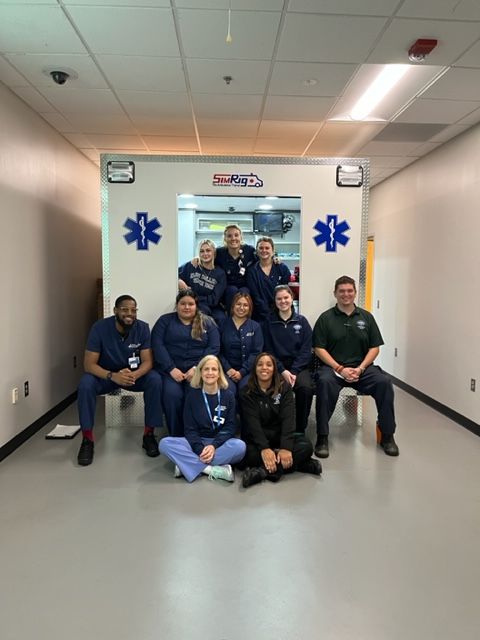An emergency pregnancy call went out on the Alamance Community College (ACC) campus in November. But all was well – because the emergency was actually part of a first-ever joint exercise between students in the Emergency Medical Science (EMS) department and the Associate Degree Nursing program. Moreover, the patient was a life-size Obstetric Manikin.
The college’s EMS and Nursing departments collaborated on this project as a way for their students to replicate what they will be doing in the real world of emergency medicine once they graduate and embark on their individual careers.
Utilizing the Emergency Medical Science department’s full-size training ambulance shell, second-year EMS and Nursing students participated in a high fidelity simulation collaboration. With a Nursing instructor leading the exercise by voicing the Obstetric Manikin’s labor and manipulating a newborn infant manikin through the birth canal, paramedic students used the skills they have learned within their protocol.
Simultaneously, Nursing students were in the department’s Labor and Delivery unit, communicating via radio with the EMS students and meeting the patient and ambulance crew to assist in a precipitous delivery.
“This simulation not only required the students to utilize their skills, but also work on interagency communication,” said Maia Johnson, the college’s EMS Department Head. “These collaborative exercises are unique to not only our programs here at ACC, but to programs around the state.”
Healthcare professionals tend to stay within the silos of their specific practices. This lack of communication and collaboration between branches of today’s healthcare professionals is a leading contributing factor to unnecessary healthcare errors, patient safety events, and additional costs, according to ACC Nursing instructor Cheryl Elliott, MSN-Ed, RN.
“Therefore our EMS and Nursing departments worked together to provide a realistic simulation to teach and practice inter-professional communication and collaboration,” said Elliott. “The simulation was a great success as our departments were able to learn more about each other’s scopes of practice and work together to provide care to a laboring woman and her newborn.”
The exercise consisted of four teams from each department putting their knowledge to the test inside the cramped quarters of the ambulance shell. Nursing instructor Aleksey Fraser voiced the life-size Obstetric Manikin and ultimately manipulated the newborn manikin inside the artificial uterus into “crowning.” EMS students talk to the patient, taking vitals and reporting other information. Upon arrival at the hospital, nursing students come aboard and take over the ultimate delivery of the infant – umbilical cord attached.
All four exercises, caught on videotape from a camera inside the ambulance shell, used the same scenario of a 36-year-old patient with a pregnancy complication of gestational diabetes.
Gestational diabetes is a type of diabetes that can develop during pregnancy in women who do not already have diabetes. Every year, 2% to 10% of pregnancies in the U.S. are affected by gestational diabetes. Giving the artificial patient this complication allows the EMS students to make decisions before transporting the patient to hand off to Nurses.
“I liked the collaboration with the nursing program and I hope we can do scenarios like that more often,” said EMS student Julie Garner. “It gives us a great opportunity to see how nurses work and it helped me personally with patient handoffs.”
“I really enjoyed the collaboration…I would like to do it more often,” said EMS student Ronnie Williams.
